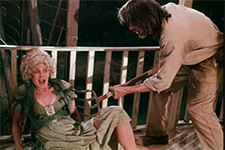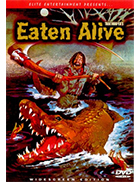Eaten Alive
|  Eaten Alive is a bizarre, rarely seen Southern Gothic horror-comedy that has been released at various times under so many different titles (including Death Trap, Brutes and Savages, Horror Hotel, and Legend of the Bayou) that it is almost impossible to keep track of all of them. This was director Tobe Hooper’s much-anticipated follow-up to his wildly successful independent horror classic The Texas Chainsaw Massacre (1974), and it bears as many similarities to that film as it does differences. Eaten Alive is a bizarre, rarely seen Southern Gothic horror-comedy that has been released at various times under so many different titles (including Death Trap, Brutes and Savages, Horror Hotel, and Legend of the Bayou) that it is almost impossible to keep track of all of them. This was director Tobe Hooper’s much-anticipated follow-up to his wildly successful independent horror classic The Texas Chainsaw Massacre (1974), and it bears as many similarities to that film as it does differences.Like Texas Chainsaw Massacre, Eaten Alive has a salaciously inviting title that promises horror and spectacle. However, while Massacre is almost completely gore-free and relies largely on music, atmosphere, editing, and camerawork to create a palpable sense of dread and unease, Eaten Alive takes a more sledgehammer approach and goes straight for the jugular, so to speak. In other words, Eaten Alive delivers all the in-your-face blood and gore that the title of The Texas Chainsaw Massacre promised, but never delivered. However, it is for that very reason that Massacre is such the superior film, and Eaten Alive will always be more of a curiosity piece than a truly satisfying movie in and of itself. The only way to truly enjoy Eaten Alive is to see it as a genially self-aware horror parody that takes many of the fear-inducing elements from Massacre, ratchets them up a notch, and then douses them with a cartoonish atmosphere and over-the-top characters. If Massacre horrifies with its realist, on-location documentary-like approach, Eaten Alive gets chuckles with its blatantly fake set and theatrical lighting scheme. Neville Brand, at the time already a veteran of some 40 movies and television shows (including his role as Al Capone on The Untouchables), stars as Judd, the cantankerous manager of the Starlight Hotel, a decrepit boarding house somewhere in the swampy muck of southern Louisiana (like the infamous Bates Motel, it is far off the beaten track, making it the perfect location for murder). The Starlight sits next to a gloomy pond, which is occupied by Judd’s pet, a giant crocodile that he claims came from Africa, can outrun a horse on land, and will never die unless someone kills it. One thing is for sure: This crocodile will never die from starvation because anyone who makes the mistake of staying at the Starlight ends up croc food. These include a prostitute on the run, a young family with a dog (the mother is played by Marilyn Burns, the lone survivor from Texas Chainsaw Massacre), a perverted hillbilly (a young Robert Englund, who would later go on to fame as Freddy Kruger in the Nightmare on Elm Street series), and the father and sister of the prostitute (Mel Ferrer and Crystin Sinclaire) who have been tracking her since she ran away from home several months earlier. The entire film takes place over one night, and Judd manages to slaughter close to half a dozen people and feed them to his always hungry pet. His favorite weapon is a giant scythe, but he isn’t above using a rake to hack up his victims first. There is no explicit reason given for Judd’s insane behavior; instead, he is simply presented as a figure of horror—another redneck from hell, a popular figure in the post-Deliverance ’70s. And, with the way the exterior of the secluded, swampy Starlight Hotel is constantly lit in a garish blood-red, the suggestion seems to be not so much that Judd manages the hotel from hell as he manages a hotel in hell. Hooper constantly plays the line between horror and comedy, giving us extreme instances of both (with at least three scenes of shapely young women undressing thrown in for good measure). For instance, he is not above generating suspense by putting a seven-year-old girl in constant danger, and he is not above a quick, sick joke like showing the family dog getting munched by the croc. He attempts to sustain long chase sequences, but the editing and the rhythm of the scenes are clumsy and rough. They don’t generate real terror. Eaten Alive has, instead of horror, an air of ludicrous hilarity, and I’m not quite sure if this is more a result of Hooper’s conscious efforts or simply the side effect of the movie’s shabby B-quality. Either way, Eaten Alive is an enjoyable distraction and a fascinating curiosity. It is still a far cry from the gut-wrenching artistry of The Texas Chainsaw Massacre; Eaten Alive is, alas, simply crude. THE DISC Video: The source element used for the digital transfer of Eaten Alive was in pretty rough shape, as it contains a number of scratches and quite a bit of general damage. The transfer appears to be clean and free of artifacts, but the overall low quality of the original print is evident. There are a few instances where color and lighting continuity change in mid-scene, and much of the film was shot with stark contrasts of red and black, all of which makes for a difficult transfer. Overall, the image quality on the disc is as good as could be expected, and in some ways the scratches and imperfections add to the movie’s overall B-picture feel. Audio: The soundtrack is digital mono. Most of the dialogue is audible and the sound effects are adequate. The overall soundtrack is a bit murky, although, like the video, this is most likely a result of the bad shape of the original audio elements. Extras: Unfortunately, there are no extras to speak of, with the exception of the original theatrical trailer. Like the movie, the trailer is an interesting curiosity piece, especially in the way it tries to capitalize on both the name recognition of Hooper and The Texas Chainsaw Massacre and the runaway box-office success of Jaws the year before. Because Eaten Alive has long been considered “the lost Tobe Hooper film,” the disc would have benefited greatly from a running audio commentary or at least some production history. Copyright © 1999 James Kendrick Thoughts? E-mail James Kendrick All images copyright © Elite Entertainment |
Overall Rating: 

 (2.5)
(2.5)


